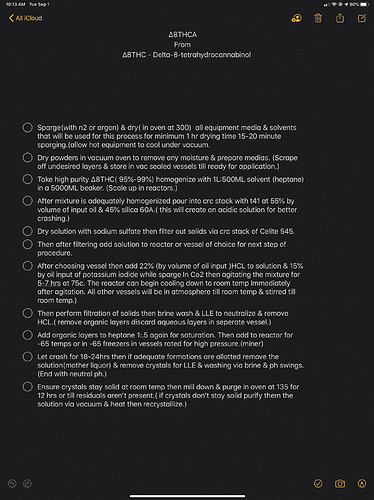The chemistry of resorcinol carboxylation and its possible application to the CO2 removal from exhaust gases
Carboxylation of Phenols with CO2 Atmospheric Pressure.pdf (471.3 KB)
I think this is the paper that the gentleman above who sugested a test with bicarbonate and thc
was talking about.
Pressurized CO2 as a carboxylating agent for thebiocatalyticortho-carboxylation of resorcinol
Pressurized CO2as a carboxylating agent for thebiocatalyticortho-carboxylation of resorcinol.pdf (1.5 MB)
or it could be this paper he was on about.
The Carboxylation of Resorcinol and the Separation of beta and y-Resorcylic Acid by Ion-exchange Chromatography
The Carboxylation of Resorcinol and the Separation of beta and y-Resorcylic Acid by Ion-exchange Chromatography.pdf (792.9 KB)
I have a funny feeling that it will not work as it is above the decarb temp of THCa and is not
under CO2 pressure which I think turns the equalibrium in favor of carboxylation.
youtube of reaction with bicarb
so if we have a look at the first paper in this post the one titled blah blah CO2 removal of exhaust blah
blah
they get a doubling of yeild just by adding a carbon dioxide atmosphere.
I would put this down to the competing reaction of heat caused decarboxylation and
the carboxylation of the phenol with the bicarb.
though untested yet I would at a guess say that this would also be the case with THC
though the temperature of decarboxylation is lower than resorcylic acid.
hence the idea of using dry ice in a pipe bomb to increase pressure and push the reaction to the
right.
Another interesting paper
Kolbe–Schmitt type reaction under ambientconditions mediated by an organic base
Kolbe–Schmitt type reaction under ambientconditions mediated by an organic base.pdf (1.4 MB)
this one is done at 30C and has reference to THCa though not directly they are hinting at its
usability for it I think.
they are getting quantative yeilds from an organic base guanadine with the resorcinol
in acetonitrile under 200 ATM of CO2

